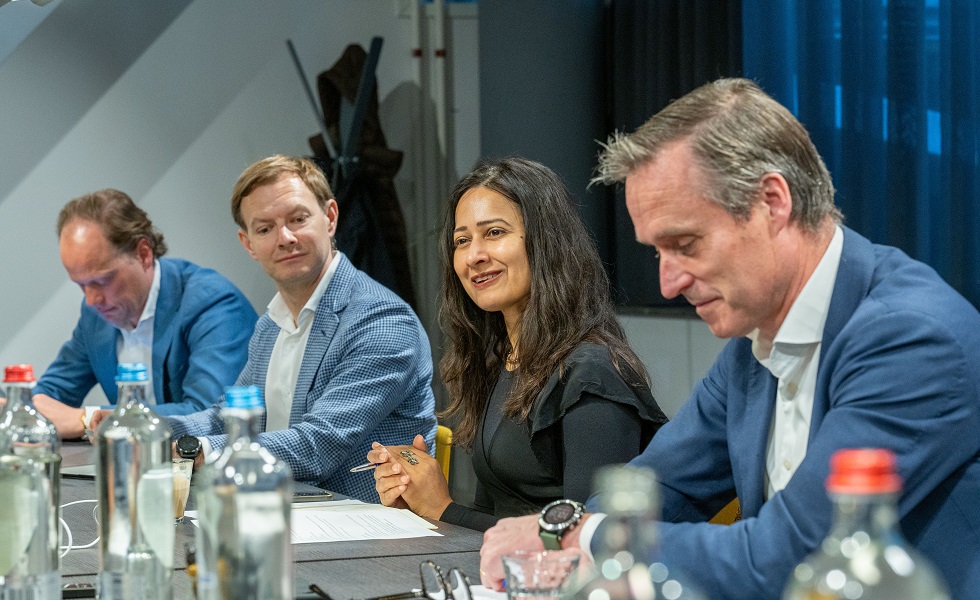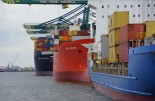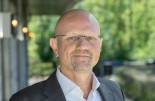Investing in the next phase of energy transition? (Roundtable Green Infrastructure & Energy Transition - part 3)
Investing in the next phase of energy transition? (Roundtable Green Infrastructure & Energy Transition - part 3)

This report was originally written in Dutch. This is an English translation.
What can we expect from new technologies when it comes to the energy transition and green infrastructure? What trends are emerging? In part 3 of the Round Table on Green Infrastructure & Energy Transition, eight investors and experts, led by Rishma Moennasing, discussed the future outlook for green infrastructure and the energy transition.
By Manno van den Berg
This is part 3 of the report. Part 1 can be read here, part 2 can be read here.
|
MODERATOR Rishma Moennasing, Rabobank Investment Office
PARTICIPANTS Angeles Toledo, Blue Sky Group Bart van Merriënboer, a.s.r. real assets investment partners Duncan Hale, Schroders Greenooat Friso Verveld, EY John Carey, L&G Lena Doan, Nuveen Mark Gilligan, AXA IM Alts Remko van der Erf, Intermediate Capital Group (ICG) |
The focus is still very much on energy generation. What are the next investment opportunities for institutional investors who want to contribute to the energy transition?
Van der Erf: 'The entire ecosystem surrounding decarbonization goes much further than just renewable energy. One of the most effective ways to reduce energy uncertainty is energy conservation. That is something you can invest in. If you install smart meters in people's homes, they will use less energy.'
Verveld: 'There are many opportunities outside of energy generation. At its core, the energy transition is about a huge system change that creates investment opportunities throughout the value chain. Battery storage is an obvious option. Grids are more difficult to invest in. But if you look at the demand side, I see many investment opportunities in industrial companies that need to become more sustainable. If they had to finance this entirely themselves, it would be extremely challenging.'
Van Merriënboer: 'In addition to renewable energy generation, we see plenty of opportunities in areas such as smart meters, energy storage using hydrogen and ammonia, and making transport more sustainable. The latter can also be achieved on a broader scale by linking logistics real estate to charging facilities for freight transport. These charging points are powered by renewable energy generation and battery storage.'
Gilligan: 'Be careful with data centers if you are looking for cash yield. We had a large platform for data centers and expanded it from 6 to 35 data centers before we sold it. This resulted in tremendous value growth, but also required capital injections to meet the demand from hyperscale customers. In Europe and North America, around 40% of the current deal flow is related to data centers. It will be interesting to see how investors deal with that yield challenge.'
Carey: 'Still, it’s an opportunity that you can’t really pass up as a credit investor. It’s a particularly interesting sector because of its long-term investment grade profile. I understand the point about equity, but for debt it’s really a different game.'
Gilligan: 'That was indeed our solution: we sold the company and then financed the buyer.'
Will clients continue to ask for impact, for Article 9 investments?
Toledo: 'Definitely, there is a clear trend toward more impact with explicit intent and measurability. That intent was generally lacking. Article 9 is a good starting point and is very meaningful, but it's not everything. Investors need to thoroughly investigate what the Article 8 or 9 labels stand for in order to avoid greenwashing.'
Van der Erf: 'In the Netherlands, the desire to make an impact is only increasing. Outside the Netherlands, you see much less of that focus. Investors often have their own framework and want to classify portfolios based on the EU taxonomy. But that is quite difficult. The CSRD would help us with that, but that obligation has now been postponed by two years. So companies do not yet have to provide that data, which does not help.'
Gilligan: 'In practice, Article 8 funds often have more impact. What I see in almost all our client groups is that no one is willing to sacrifice 300 basis points of return for more impact. They want the financial arguments to be leading, supported by ESG elements. But our strategy is very clear: every asset we buy must have a credible path to net zero by 2050.'
Doan: 'We invest in sustainable infrastructure and energy security. It depends on what the client wants. We have an opt-out for midstream infrastructure and LNG if investors are not interested in these subsectors. Returns are important, but it's also about how you support the energy transition through active engagement with the companies in your portfolio. Many investors care about the same things, but express it in different ways.'
Do you invest in new technology, or do you wait until it has proven itself?
Carey: 'You have to be careful about how much technology risk you are willing to accept. There is a lot of enthusiasm around clean tech, but in my view, technologies at a very early stage are not yet infrastructure assets, but fall under venture growth or private equity growth. Look at the past 25 years: investors took risks with unproven technologies, for example in waste processing, and that often turned out badly.'
Toledo: 'Do you opt for scalability or innovation? These are different risk profiles. We often come to the conclusion that scalability adds more impact and is less risky. Of course, there are pension funds that are willing to take more risk and invest in innovation, but that requires a longer-term perspective.'
How do you see the role of nuclear energy?
Hale: 'We certainly believe that nuclear energy will play a major role in the energy transition. However, these are very long-term projects, which means they are only suitable for a specific group of investors. We don't usually invest in nuclear energy in broad mandates, mainly because it's an emotional topic. However, the systematic value of nuclear energy should not be underestimated.'
Van der Erf: 'What I find interesting is that many investors are personally in favor of nuclear energy, but their RI policy still excludes it.'
Van Merriënboer: 'I think we are still underestimating one risk: the storage of nuclear waste. There is still no real solution for this. But the debate is shifting. We also see nuclear energy as an important link in the energy transition, especially for baseload capacity. However, there are still few investments, partly due to the extremely long time frame.'
Toledo: 'There is a change in mentality underway. Nuclear energy is necessary, but at the moment it is probably still a bridge too far for many pension funds.'
Carey: 'There is still a long way to go to rebuild supply chains and expertise. Even in the US, few nuclear power plants have been added in recent decades. So it's a complicated investment story. Nuclear energy also requires a lot of government subsidies.'
There is a lot of investment in AI. AI requires data centers, which in turn consume a lot of energy. Is that also an investment opportunity for you?
Van Merriënboer: 'This is one of the most important trends alongside the energy transition: digitization combined with AI. Data usage, even at home, has exploded in recent years. We want access to Netflix anywhere and anytime. That requires enormous capacity via data center infrastructure. Is it hype? Perhaps in part. But it's too good an opportunity to pass up.'
Toledo: 'I think AI will accelerate the energy transition. We are already seeing projects in which AI is being used to make processes more efficient: in contract management, in grid management. However, we must remain alert to the negative effects on the environment and the social consequences, for example for employment. And what are the risks and how do we remain in control if algorithms start to determine more?'
Verveld: 'If you look at what AI models can do now, compared to one, two, or three years ago, you see more than exponential growth. That calls for a public debate about the risks. What is the government's strategy? How will this affect us and what safeguards are needed?'
Hale: 'AI is creating a growing divide between green and brown energy. The increasing demand for energy from data centers is mainly focused on green energy. For the first time, we are seeing a real price difference between long-term green and brown energy contracts.'
What is your vision for the future of green infrastructure?
Toledo: 'We still see many opportunities within the energy transition. At the same time, ESG and sustainability must remain at the top of the agenda. From an impact investing perspective, we believe this area will only continue to grow.'
Doan: 'There are many investment opportunities in the energy transition, across the entire capital structure. But whether it's renewable energy, energy efficiency, or battery storage, loans will play a major role.'
Hale: 'Traditionally, large institutional investors have been the main investors in this sector. But with the emergence of semi-liquid structures, high net worth individuals can now also invest directly in energy transition projects.'
Van der Erf: 'The appeal of infrastructure as an asset class will increase. We are living in a time of high inflation, geopolitical uncertainty, faltering supply chains, and tensions in global trade. Infrastructure offers non-cyclical cash flows and predictable, low-volatility returns. This is truly a sector where capital can be put to work.'
Carey: 'The capital requirements for new infrastructure are enormous – both in equity and debt. Many banks are becoming more selective in granting long-term loans, and institutional investors are becoming increasingly important as long-term capital providers. We are also seeing more platforms emerge that are shifting allocation from listed equities and bonds to private market instruments. Opportunities are emerging in the private market, particularly for DC pension capital.'
Van Merriënboer: 'As an asset class, it has proven to be robust, even in times of turmoil.'
Verveld: 'The macroeconomic drivers for infrastructure remain very strong. In the short term, I do see challenges for the energy transition, particularly due to social resistance to higher prices. This makes the rollout of renewable energy somewhat more difficult. The challenge is also: how do we keep industry in Europe while accelerating the energy transition?'
|
SUMMARY Geopolitical unrest and the withdrawal of the US are creating a need for Europe to accelerate its efforts in the areas of energy security and green infrastructure. Private investors are taking the lead. Governments remain cautious, while pension funds and other institutional investors are playing an increasingly important role. Biodiversity is becoming a must. Biodiversity risks and opportunities are becoming increasingly decisive. Grid capacity is a bottleneck. Grid connection is a growing risk. AI is driving up energy demand. Digitalization and AI are fueling demand for (green) energy, especially through data centers. Nuclear energy is back on the radar. More and more parties see nuclear energy as necessary for the energy transition. We believe that despite the political turmoil, there are still plenty of opportunities for attractive investments in renewable energy. There is a huge opportunity to bring supply chains to Europe and thus become less dependent on the rest of the world. Data usage, even at home, has exploded in recent years. Is it a hype? Perhaps in part. But it's too good an opportunity to pass up. |
|
Rishma Moennasing Rishma Moennasing is Lead Investment Funds & Mandates at Rabobank Investment Office and, as project leader for SFDR, MiFID ESG, and EU green taxonomy, is responsible for the implementation of all green EU rules for investments. She has been with Rabobank since 2008 and previously held a similar position at ABN AMRO Private Banking & Asset Management. She is also active in the VBDO. John Carey John Carey leads the Infrastructure Debt team at L&G Real Assets in Europe. Before joining the company in May 2023, he worked at IFM Investors. Prior to that, he held a number of positions in the infrastructure sector at Barclays, KPMG, and Moody's in the areas of banking, consulting, and credit ratings since 2001. |
|
John Carey John Carey leads the Infrastructure Debt team at L&G Real Assets in Europe. Before joining the company in May 2023, he worked at IFM Investors. Prior to that, he held a number of positions in the infrastructure sector at Barclays, KPMG, and Moody's since 2001, in the areas of banking, consulting, and credit ratings. |
|
Lena Doan Lena Doan is Managing Director Energy Infrastructure Credit at Nuveen. She has experience in investments within capital structures, energy markets, and management companies. Before joining Nuveen, she worked at HPS Investment Partners in private credit and renewable energy. Prior to that, she worked at Carlyle and Denham Capital. She started her career in investment banking at Citi and later as a trader at Calpine. |
|
Remko van der Erf Remko van der Erf is Managing Director at Intermediate Capital Group (ICG) and responsible for the Benelux region. ICG has been financing medium-sized European companies since 1989 and launched a European Infrastructure Equity strategy in 2018, followed by a strategy focused on the Asia-Pacific region in 2022. Van der Erf has gained extensive experience in alternatives during his career at Robeco and Van Lanschot Kempen. |
|
Mark Gilligan Mark Gilligan is responsible for AXA IM Alts' infrastructure equity platform. The investment strategy is based on the belief that climate change is the defining issue of this century and focuses on developing, building, and operating infrastructure that is suitable for or adaptable to a sustainable net-zero world. Key themes for the strategy are decarbonization, electrification, and digitalization. |
|
Duncan Hale Duncan Hale joined Schroders Greencoat in 2022. He works within the private markets business, with a particular focus on managing Schroders Greencoat's product offering in the asset management and defined contribution market. Before joining Schroders Greencoat, Hale worked at WTW, where he led their secure income capability. |
|
Bart van Merriënboer Bart van Merriënboer is Senior Portfolio Manager Infrastructure at a.s.r. real assets investment partners. Since 2007, he has been involved in the selection, monitoring, and implementation of asset managers and portfolio construction and management for institutional investors. Van Merriënboer has over 30 years of experience in the financial industry, starting out in derivatives and fixed income, then moving on to equities and hedge funds, and now working in the field of private assets. |
|
Angeles Toledo Angeles Toledo works at Achmea Investment Management and is an experienced impact investor and advisor to pension funds. Until recently, she was Head of the ESG and Impact Investment Team at Blue Sky Group. Prior to that, she worked as Fund Manager of the Triodos Groenfonds. Toledo has been nominated several times for the Top 50 Women in Sustainable Finance in the Netherlands. |
|
Friso Verveld Friso Verveld is a Partner at EY. He uses his expertise in project financing and investments in sustainable energy to facilitate financing for sustainable infrastructure and the energy transition. He focuses on creating win-win situations for all parties involved, with the aim of accelerating the green economy. |



















